#Ashikaga Yoshimitsu
Explore tagged Tumblr posts
Text

I need to confess my sins. I'm in love with Ashikaga Yoshimitsu.
8 notes
·
View notes
Photo

A pamphlet from Kinkakuji Temple (金閣寺) in Kyoto, originally a villa purchased by the shōgun Ashikaga Yoshimitsu (足利義満) (1358-1408) but converted into a Zen temple after his death according to his wishes, with the cover featuring the famous golden pavilion for which the temple is named, rebuilt in 1955 after being burned down by a troubled novice monk in 1950
Acquired at the temple May 6, 1994
#buddhist temple#京都#kyoto#金閣寺#kinkakuji#鹿苑寺#rokuonji#臨済宗#rinzai#zen buddhism#japanese architecture#japanese history#足利義満#ashikaga yoshimitsu#pamphlet#ephemera#printed ephemera#paper ephemera#crazyfoxarchives
24 notes
·
View notes
Link
Ashikaga Yoshimitsu was the third shōgun of the Ashikaga shogunate, ruling from 1368 to 1394 during the Muromachi period of Japan. Yoshimitsu was Ashikaga Yosh...
Link: Ashikaga Yoshimitsu
0 notes
Text

OS DO ROCK EU SEI QUEM SÃO
#Inu oh#Tomoari#caralho ashikaga yoshimitsu se eu te apanhar na rua vais ver prego-te uma lambada nem sabes de que terra és
385 notes
·
View notes
Text







Sean bienvenidos, japonistasarqueologos, a una nueva entrega, cultural-artística vamos a hablar sobre Kinkaku-ji una vez dicho esto pónganse cómodos que empezamos. - El kinkaku-ji se localiza en la ciudad de Kyoto, en la prefectura de kansai. Kyoto fue una de las dos grandes capitales del Japón feudal porque su otra ciudad de gran peso fue Nara, pero eso es otra historia. - El Kinkaku-ji, fue construido en el siglo XIV, el que se ve actualmente es una reconstrucción porque el original se destruyó en un incendio en 1950 y el actual data de 1980 aproximadamente ya en 1880 perdió su revestimiento de pan de oro, fue La residencia de Ashikaga yoshimitsu tras su muerte lo donó a la orden religiosa y pasó a ser un templo budista. - Espero que os guste y nos vemos en próximas publicaciones. Fuentes de foto: https://blogukiyoe.es/kinkaku-ji-en-el-ukiyo-e wikipedia - Welcome, Japanese archaeologists, to a new cultural-artistic installment, we are going to talk about Kinkaku-ji. Once that has been said, make yourself comfortable and we will begin. - Kinkaku-ji is located in the city of Kyoto, kansai prefecture. Kyoto was one of the two great capitals of feudal Japan because its other major city was Nara, but that is another story. - The Kinkaku-ji was built in the 14th century, the one currently seen is a reconstruction because the original was destroyed in a fire in 1950 and the current one dates from approximately 1980 and in 1880 it lost its gold leaf coating, it was La residence of Ashikaga Yoshimitsu after his death he donated it to the religious order and it became a Buddhist temple. - I hope you like it and see you in future posts. Photo sources: https://blogukiyoe.es/kinkaku-ji-en-el-ukiyo-e Wikipedia - 日本の考古学者の皆さん、新しい文化芸術の回へようこそ。金閣寺についてお話します。それが終わったら、落ち着いてから始めましょう。 - 金閣寺は関西県京都市にあります。京都は、もう一つの主要都市が奈良であったため、封建時代の日本の二大首都の一つでしたが、それはまた別の話です。 - 金閣寺は 14 世紀に建てられ、現在見られるものは再建されたものです。オリジナルは 1950 年の火災で焼失し、現在のものは 1980 年頃のもので、1880 年に金箔のコーティングが失われ、ラ邸でした。足利義満の死後、教団に寄進され仏教寺院となった。 - 気に入っていただければ幸いです。今後の投稿でお会いしましょう。 写真出典: https://blogukiyoe.es/kinkaku-ji-en-el-ukiyo-e ウィキペディア
#Japan#kyoto#kanto#art#photojapan#tumblrphoto#history#unesco#architecture#archaeology#Ashikagayoshimitsu#buddhism#日本#京都#関東#アート#写真日本#歴史#ユネスコ#建築#考古学#加賀義光#仏教#photography#geography#地理#culture#文化
39 notes
·
View notes
Text
Himehiko Timeline
This is my best attempt to gather the information we get about the Tamasaka Himehiko line and thus the game universe timeline. It is based on what I've found in the game and bonus material, but it may yet be incomplete. If you have any information I'm missing, please let me know. It's also always possible we get more lore drops in extra material.
It'll be behind a cut, so I will edit any additional information into the post. If I add things, I'll try to keep track here of when the last edit was. This will obviously contain spoilers for the full game (especially Kisa's route - major spoilers for Kisa's route) as well as bits of side material. Specifically the First Anniversary Short Story and the Summer Light Novel, though also the pre-release short stories on the website and others.
Shout out to the other people who seem to have independently attempted the same project, including Anemone (@ snowblossom_jj on twitter) for something to double check myself against. Before I go right into the Himehiko Timeline, I'm going to put in some Japanese Theater History for context, though it's worth noting none of this is referenced specifically in the game and may differ within the Jack Jeanne universe.
As always, happy to answer questions via asks or elsewhere if you have them.
Japanese Theater History potentially of note.
1374 - Kan'ami (観阿弥) and 12 year old son Zeami (世阿弥) perform what would become known as Noh for the teenage shogun Ashikaga Yoshimitsu (足利 義満) who is so impressed by Zeami he gives him patronage. Zeami is educated in court and eventually becomes the Shogun’s lover. At 22, after his father’s death, he takes over the family troupe and begins to integrate his classical education and Buddhist instruction into the art. He goes on to formalize Noh, write plays for it, and treatises on acting and the Philosophy of Drama that continue to be informative to this day.
Of note, the idea of “hana” 『花』 is one of his core tenants, and his formulation of “the flower of youth” vs “the flower of experience” is referenced in game, though not credited.
1603 - Izumo no Okuni (出雲 阿国) creates Kabuki. It is originally performed by a troupe of all women.
1629 - Women are banned from Kabuki for “morality” leading to the form being taken over by “young men” who are later also banned for being too sexy, in moves through the next several decades.
Probably by the timeline we are given for Tamasaka, in our world, Kabuki would have been established as an all male form of theater, with men playing women’s roles referred to as “onnagata” as they are to this day. It is unclear if this history happens the same within the Jack Jeanne universe, as no mention of Kabuki itself happens in game, and Tamasakaza isn’t placed within it as a larger tradition, despite being described in much the way Kabuki is, suggesting perhaps in the Jack Jeanne universe, history diverges at some point.
1680s - Bunraku, (then known as Jourui) a form of Puppet Theater takes on something close to its modern form and starts becoming increasingly popular. Many famous Kabuki plays were originally written “for the puppets” and the literary tradition is considered overlapping.
1683 - Chikamatsu Monzaemon (近松 門左衛門, 1653 – 1725) has his first verified play produced. He is sometimes called the “Shakespeare of Japan”. He would continue writing plays for both puppet theater and kabuki, until around 1715. He was a writer, but did not act. He is most famous for his lovers’ suicides.
HIMEHIKO TIMELINE
1st Himehiko - His name was Chuza Tsukihiko (中座月彦), and he lived sometime in the “mid-Edo period’ about 300 years before the present. Specific dates are hard to pin down, but we’re looking at around (or maybe a little before or after) 1700. It is likely not exactly 300 years ago, give or take a few years, as no one in the game mentions any kind of anniversary, and you’d assume the 300th (or 200th of the established settled troupe) would be marked and mentioned.
He’s canonically called a "bishonen" and was known to be able to play both male and female roles. At this time, in our universe, no women would have been allowed on stage. We know his troupe was all male.
He receives the patronage of a local lord (much like Zeami) - the lord of the castle in Hiraki - Hiraki Matsubara (開松原). Matsubara was considered very talented and is credited with the town flourishing under his rule as well as the creation of Tamasaka and Tamasakaza.
He is given the name Tamasaka Himehiko 玉阪 比女彦 which he takes on, and which becomes the title passed down. (The name "Tamasaka" is mentioned to maybe be a play on the word 『偶さか』 implying a "rare, unusual kind of talent")
Though the troupe itself will be considered a traveling troupe for the next 100 years, it seems to have a sort of home base on that lord’s land. They are given land for a stage there, the forebearer of the Tamasaka theater that exists to day.
We know little about him, but one thing we know is that he was quite fond of the story of the catfish god in Ayahama (which is historically near where Hiraki Castle is), and used to dance in tribute there. The relationship between Tamasaka and the hot springs goes back all the way to him.
There is one Wisteria tree on Mt. Oodate, and he is said to have been fond of it. (Fuji Musume - 藤娘- is one of the most famous Kabuki dance/plays, though technically it would have, in our universe, postdated the first generation Himehiko, it is likely a reference).
He dies of “severe, violent emotional suffering”.
He is enshrined in Himehiko shrine, and may actually be buried there. He is worshipped there as a god of theatre, and a bringer of fortune in other endeavors as well. This would imply the shrine is established well before the troupe settles.
2nd - The next Himehiko is the elder brother of the first. We don’t know if the rule that was later in place that the title be passed to someone under the age of 30 was in place yet. It may imply that the troupe, like Zeami’s was a family affair at least in part, from the beginning, if his brother was considered the natural next head.
3rd - The eldest son of the 2nd.
History that happens at an unclear point in the timeline after this --
At some point after this, though it does not seem to be specifically after the 3rd, in the way it’s told, one generation of Himehiko will choose to pass the title onto an adopted son. Rather than the adopted son taking the Chuza name as well, this son becomes the start of a new branch family, known as the Tamasaka branch. From this point on, the title will occasionally pass between the Tamasaka and Chuza branches, eventually developing into quite the rivalry. The Tamasaka branch became known as “true flowers” or the more talented of the two branches. The exact timeline of all of this unclear.
At some point, after several early, tragic deaths of people carrying the Himehiko name, both branches of the family begin to speak of a “Himehiko Curse” - which causes those who take the title to die young. They believe in this so strongly that people from both branches will sometimes pass up the title, or defer it, to try to avert the fate. However, it doesn’t seem to be something that affects every Himehiko. Just enough of them for it to be considered a threat in the family.
How it operates and if it is one of the genuine supernatural forces in the Jack Jeanne universe is unclear. The first Himehiko dies of severe mental suffering. The cause of death for others is not established.
It is possible that, either supernaturally or non-supernaturally, it is the distillation of the stress, politics, rivalries, burdens, and expectations of the theatre.
All of this happens and is well established between the 3rd Himehiko and the 10th Himehiko, but specifics are vague.
At some point, a rule is added that the title is past to a young man under the age of 30.
It seems some people may pass the title down before they die, rather than it only transferring via death. It is unclear the effect this has on the curse within the narrative of it. At another point, rather than taking the full stage name of Himehiko, each generation takes only half as their stage name - either Hime or Hiko, plus an additional character. This was done to try to avoid the “curse”. It does not work.
4th - A tree in the courtyard of Himehiko Shrine, which contains many trees, including many fruit trees, is said to have been planted by him. All we get is that the tree is “planted in the lucky direction.”
It is possible this is an Ume tree, which apparently can be considered a protective charm against evil and is traditionally planted in the northeast corner of a garden. Other than this, I can’t find much — the other mentions of lucky directions change by year, and don't seem to be what’s being referred to.
5th - nothing is known
6th - nothing is known
7th - Established Tamasaka Drama School as per random Neji encounter. Neji says he ‘fell in love with…’ and is then cut off. We get no other info from that encounter, or elsewhere.
It’s possible that the establishing of the Drama School coincided with the settling of the Troupe from a traveling one to a stationary one, but that’s not mentioned directly. If so, that would put 7th at about 100 years after the 1st, and about 200 years before the present.
It is unclear if from this point on all Himehiko’s also serve as Principal of the School or not.
At some point “several generations back (from present)” the principal of the school plants Night Jasmine on Mt. Oodate.
(About 200 years ago, the Takashina Style of dance is founded as a family dance tradition. It has no association with Tamasakaza, but given it’s part of the timeline we get, plus the Kabuki/Nihon Buyo overlap in our universe, I’m putting it on here.)
8th - The tree he planted at the shrine is the most prominent one. No other info is known.
9th - nothing is known.
10th - From the Tamasaka Line. Very likely the older brother of the 11th - According to the Anniversary Short Story, he dies a shocking and tragic death (that would fit within the narrative of the Himehiko Curse). The title would then be passed to his younger brother.
11th - Real name Tamasaka Shikitoshi 玉阪 志木年 - stage name unknown. He is the current head of the troupe during the Meiji era merger of Hikari and Tamasaka, as depicted in the Anniversary Short Story. That takes place in 22nd year of the Meiji Era - 1889, giving us our first firm date.
According to Tancho, the lead Hiko actor at the time was rather critical and nagging of him, but in the events depicted in Neji’s play, ultimately is willing to almost give his life to protect 11th.
In Neji’s telling of the events he is described as innovative, as well as a very shrewd politician. And rather indifferent or reckless about threats against his own life.
He has two daughters and no sons. Presumably no one else in the Tamasaka branch has any sons of eligible age either. To prevent the name from passing back to the Chuza branch, and perhaps as a test on the limits of the Himehiko Curse, to see if it would spare women, Shikitoshi passes the title to his second daughter.
We have no information on why not the first daughter - whether she was over 30, or less skilled, or didn’t want it - all we know is that he passed it to his second daughter.
12th - The second daughter of the 11th. Member of the Tamasaka Family. First and only female Himehiko. The tree she donated to the shrine is marked with an actor’s crest of clappers — something recognizable as specifically belonging to her.
Despite being a woman, she was not just a figurehead, and actively acted in Tamasaka Plays. There is at least one that she was quite fond of, that involved a Kimono salesperson and a woman walking around on “Izayoi” - a play that the troupe stopped performing after her early and tragic death.
Tagane was involved in a revival of this play at some point, likely a pretty clear sign of his loyalty to the Tamasaka Branch faction.
At some point, it is likely that she placed a platinum Kanzashi bearing her crest in a wooden box in a tree hollow near Himehiko Shrine, following the superstition and custom born out of the Tamasaka play “Tearful Kanzashi." “Tearful Kanzashi" depicts a young woman (the fourth daughter of a man with no sons, who is abused and locked away by her father in anger after her birth also kills her mother) putting the Kanzashi her lover gives her into a tree by a shrine she stops at to pray to be reunited with him in the next life, before throwing herself off a cliff. (For more, see the Summer Light Novel chapter).
This also takes place on the 16th night of the lunar cycle. It is unclear if the play is the same one — but since the summary is given to Suzu and Kisa by a Kimono salesman, it seems unlikely that it wouldn’t include that detail if it were the same — rather it seems likely Tearful Kanzashi predates the 12th, and Tamasaka just has a lot of plays that use "Izayoi" in them.
This may indicate that the 12th takes her own life like the woman in the play, but it’s all speculation beyond that her death fits within the narrative of the Himehiko Curse.
After her early, tragic death, the title passes back to the Chuza Branch, and the whole incident/experiment is considered a disaster.
12th's older sister, and thus the surviving Tamasaka Branch go into hiding of some kind. She has children, thus continuing the line, under an assumed name. The Tamasaka branch retains supporters both in the troupe and the town, who believe that the Tamasaka branch have true talent that the Chuza branch lacks.
13th - Chuzu Dairi (中座内吏), stage name Uchihime (内比女).
After the death of the 12th, the title passes back to the Chuza line for the first time in 80 years. He quickly makes a new rule, reserving the Himehiko title for the Chuza branch, further pushing the Tamasaka branch into hiding and out of power.
We know he was born in the Meiji era (ended 1912) and lived until Showa (started 1926).
He had a strong interest in western style plays and musicals, and is the one who renamed the Tamasaka Drama School to Univeil Drama School, as well as changing the roles from Hiko and Hime to Jack and Jeanne within the school.
(For what it’s worth, Takarazuka is started in 1913. It was based heavily on western, particularly French musical Revue in direct contrast to Kabuki. It was started by a businessman in the city of Takarazuka as an all women’s theater company. Much of Jack Jeanne is based on a gender swap of Takarazuka as inspiration, but its timeline and the actual style of Tamasaka do not match Takarazuka. But this is a Himehiko Timeline so no more on Takarazuka for now.)
He apparently made a good deal of innovations to the troupe as well, and seems to have been quite active and hands on in both.
It’s hard to pin down how long and exactly when he lived and was in charge.
Kisa’s class being the 78th class would put the first numbered class in 1942, which is a particularly strange year for a traditional theater school in Japan for young, fit boys to be rebranding to a western aesthetic. It would literally be months after the attack on Pearl Harbor and several years into a war that greatly disrupted all forms of theater, calling most able bodied men to arms, rather than dance - so that’s something to consider when trying to fit the timeline. Perhaps there are years missing - a reversion to the old name, a pause in the numbering, but for some reason they pick up from where they left off, rather than restart? There is no indication in any material of any of this, either way.
14th - Takahiko (鷹彦) - the grandfather of Chuza Shuri, the current/18th Himehiko. Written with the character for “Hawk” and is noted as having very sharp eyes, but otherwise looking very much like Shuri. The game’s timeframe puts him taking up the title some time when black and white portraits were still most common, but recent enough that an old lady alive and walking around Tamasaka remembers him as a young man.
Apparently, he married a wealthy local family’s daughter after taking the position of Himehiko - and this old woman remembers having a crush on him at the time, and being disappointed - so one could guess that she was at least in her teens then.
The game’s menu actually says he’s the one who designed the school, rather than 13th - so perhaps Takahiko is the one who designed it architecturally - even if the rebrand happened before hand.
15th - nothing specifically is known
16th - nothing specifically is known
17th - nothing specifically is known
We know nothing about these or the order they were in, but one was almost certainly Shuri's father. In the anniversary short story, Tancho mentions Shuri's father by name. His name seems to have been Chuza Osamu (中座倫). From what Tancho says, the implication is that Shuri's father maybe have been principal before him, whether right before or not is not clear, or if he served this role concurrent with the title of Himehiko or not is also unclear. As previously stated, it's unclear if Principal of the School and Head of the Troupe are jobs all Himehiko's serve as part of the title, or if only some do. So it's possible that he held one and not the other or one for longer than the other - i.e. continued running the school after passing the name down or something.
All we get is the name, and that Tancho both knew/knows him and what his preference for incense was/is (and that its different than Shuri's).
It is possible an uncle and/or brother of his also held the position, as there is a nephew of his in Tamasakaza right now, which means Shuri has at least one (almost certainly) older sibling.
18th - Chuza Shuri (中座秋吏), stage name Akihime (秋比女) (Written with the character for Autumn, a kanji from his given name).
Currently the principal who is not well liked by Tamasaka Elders. Still seems to technically be the head of the troupe, but displays no desire to actually do anything onstage and finds his obligations to the Troupe to be a chore. Considers himself decent enough at both dance and singing (apparently singing is something Chuza branch is usually considered weaker in, or so he says).
He is in tension with the board over many things - Chui says the situation around him is “worse than you know,” implying there may be far more going on than anyone tells Kisa, and thus the player.
The Tamasaka Elders seem, from what we’re told, to want to make Univeil into more of a training school for Tamasaka (again?) - and Chuza is resistant to the idea.
19th - In a weekend event, the old lady in Tamasaka who tells Kisa about the 14th seems to state Akihime is the previous rather than current Himehiko (at least in the English). But everyone else seems to refer to him as the current one. Maybe she’s misremembering, maybe she’s got Opinions on his lack of participation and how much the board hates him - which she also mentions. Who knows.
The two candidates for the position seem to be Chui - the Tamasaka branch heir, and already seen as kind of a god, and Shuri's nephew (mentioned in a VERY missable Sou event on 8/1 - who is currently a Hime actor in Tamasaka, who is “treated like a king” as part of the Chuza family there. He apparently doesn’t resemble Shuri much.)
One presumes the Tamasaka board has its factions on which one they support, and, regardless, are preparing them to hold the position more to the boards liking than Shuri.
#jack jeanne#jack jeanne lore#tamasaka himehiko#lore hunting#timeline#reference#the brainrot is bad#really bad
18 notes
·
View notes
Text
A look into Japanese history part 4
Muromachi Period (1336 - 1573 AD):
Emperor Go-Daigo restores imperial power in Kyoto and overthrows the Kamakura Bakufu in 1333.
Kemmu Restoration in 1334 attempts to revive imperial authority but fails due to incompetent officials and lack of support from powerful landowners.
Ashikaga Takauji challenges the imperial court, captures Kyoto in 1336, and establishes the Ashikaga shogunate.
Two imperial courts, Southern and Northern, exist for over 50 years, engaging in battles.
The Southern court gives in to the Northern court in 1392, leading to the reunification of Japan under imperial rule.
Ashikaga Yoshimitsu (1368 - 1408) establishes the Muromachi Bakufu, controlling central provinces and fostering trade relations with Ming China.
Economic changes lead to the development of markets, towns, and new social classes.
Rise of provincial military families (ji-samurai) who become powerful feudal lords (daimyo), controlling different parts of Japan.
Arrival of Portuguese traders and Jesuit missionaries in 1542 introduces firearms and Christianity to Japan.
Oda Nobunaga emerges as a powerful warlord, capturing Kyoto in 1568 and overthrowing the Muromachi Bakufu in 1573.
These events set the stage for the beginning of the Sengoku period (Age of Civil Wars) and the unification of Japan under leaders like Oda Nobunaga, marking the transition to the Azuchi-Momoyama period.
4 notes
·
View notes
Text
Inu-oh Part 11
Plans Set in Motion,
The following week, two assistants who worked for the shogun arrived at Inu-oh's estate. One of the assistants handed Inu-oh's father a letter and he opened it to find out that it was an invitation.
"Shogun Ashikaga Yoshimitsu will be having a party in Kitayama. He's expressed his desire for the hei-za to perform."
Inu-oh's father smiled and bowed. "I am unworthy of such a great honor. To be invited to perform for the shogun himself after dedicated so many years to perfecting my craft-" He spoke before he was interrupted.
"No, not you. Inu-oh." The man spoke. Inu-oh's father's eyes widened in shock and he quickly read the letter again. There it was, Inu-oh's name on the invitation. He frowned when he saw Hana's name on the invitation as well. That woman...He looked back to the man in front of him.
"But sir, I am the lead performer for the hei-za!" Inu-oh's father insisted. The assistant closed his fan and opened it slightly, before closing it again.
"As I understand, Inu-oh's following has grown much larger than yours. The request for Inu-oh comes from Nariko, the shogun's wife. Otherwise, Kanze's troupe would have been invited as usual. The Kanze troupe is the shogun's favorite after all." The man smirked before he gestured for the other assistant, sitting beside Inu-oh's father. He leaned in closer and whispered into Inu-oh father's ear.
"There's something that you must tell me. Rumor has it that hiding under the mask that Inu-oh wears is the face of a monster. We like to know if that's true." He asked. "Because you should know, Lady Nariko is with child right now. If we have to take that under consideration, she's in no condition to see anything disturbing. If anything were to happen to her, the person responsible will have to executed on the spot. Do we understand each other?"
Inu-oh's father smirked. "Yes. That makes all the sense in the world."
The two men left the estate and Inu-oh's father called Inu-oh and his other two sons to meet him in the practice room.
"You called for us?" Inu-oh questioned, cautiously, wondering what his father wanted. Whatever it was, it couldn't be good. It never was with his father. His two brothers followed in behind him and his father told him to sit. Inu-oh was wearing a red kimono and a boar mask with an opened mouth. Inu-oh's father held out the letter to Inu-oh. Inu-oh took it from him, wondering what it was and read it. Inu-oh's eyes widened in shock, seeing that it was an invitation from the shogun himself asking to perform for his wife. Then Inu-oh's gaze fell upon Hana's name on the invitation widening a little when he saw it. His two brothers stood behind him, reading over Inu-oh's shoulders.
"Inu-oh! That's amazing!" One of his brothers smiled.
"The shogun, himself!" His second brother exclaimed.
"The shogun has made one more demand of you. It's very important to do. You must perform your final act without the mask." The three of them gasp and looked up in shock. Inu-oh gripped the paper, tightly in his hands and looked down avoiding his father's gaze. "He says that he wishes to see the face that's hidden beneath it. He's used to watching Kanze performances and Fujiwaka's so handsome that he often dances without a mask at all."
"But Inu-oh can't!" One of Inu-oh's brothers protested.
"And if I refuse?" Inu-oh asked, calmly. His father scoffed and rolled his eyes.
"Then they'll rescind the offer. But if they see how hideous your face is, you may lose your head entirely. You're better off-" Inu-oh cut him off quickly.
"I understand. I'll do it. I'll do as he says." He spoke. "But on one condition...I want a biwa player and a singer."
Inu-oh quickly met with Hana and Tomoari and showed them the invitation. "This is the final act. However, I must remove my mask once it's over." Hana's eyes widened, staring at him in disbelief while Tomoari laughed.
"Of course, you of all people would do that!" He exclaimed. But Hana didn't laugh.
"Are you crazy? What were you thinking?" Hana shouted.
"I got us a way into the shogun's castle. This is the only way." Inu-oh told her. Hana sighed realizing that he was right.
"We do have to get on his good side, in order for us to get closer to him. But I just don't like it. Something feels wrong about this." She spoke. "I guess if worse comes to worse, we could always make a run for it."
"Nothing's going to happen." Inu-oh assured her.
"How do you know that?" Hana replied.
"Because I have the best singer and biwa player by my side."
"But I don't want to see you die in front of me!" Hana cried. Inu-oh sighed and turned to Tomoari, looking for help, who only shrugged. Inu-oh turned back to Hana and hugged her. Maybe it was time to tell her when he can.
"Hana, look at me." He told her. She slowly lifted her head and Inu-oh wiped the tears from her eyes. "I've been thinking. Once this is all over and if I do come out alive. Will you stay with me?" Hana blinked at him confused.
"Of course, I will.-" She immediately answered. Inu-oh stopped her.
"I wasn't finished." He sighed deeply. Hana stared at him, wondering what he was struggling with to tell her.
"Go on." She encouraged him.
"Will you be my wife?" Inu-oh told her. Hana's eyes widened and gasped softly. "Will you marry me, Hana?"
Inu-oh saw her starting to tear up again before she threw her arms around his neck.
"Yes! Of course, I will!" She smiled. Tomoari smiled watching the two.
"I guess we're going to have to plan a wedding after this, won't we?" He chuckled. Inu-oh hugged Hana back.
"Then let's do this! Tomoari, you go and start warming up the crowd, while Hana and I get the others and start setting up for what we need for our last act." Inu-oh told him.
"Will do." Tomoari nodded and walked away, leaving Inu-oh and Hana alone. Inu-oh noticed that Hana was a little quiet and noticed that she was thinking about something.
"Is there something wrong?" He asked her.
"You do know that there's an eclipse coming in a few days." Hana told him. Inu-oh's eyes widened a little in surprise and he shook his head. "No, I didn't."
"I just find it weird why the shogun chose that particular day to have a party. But then again there is a saying that eclipses could be a sign of good luck or bad luck. The spirits tend to get stronger as well as the sun and moon combine. Maybe the Heike spirits will finally find their peace."
"Hana how do you know much about spirits?" Inu-oh asked her.
"It was something that my mother told me when I was little. She was better at it than I was. I guess that's how I was able to see spirits was because of her and got my singing voice from her as well." She told him. "Come to think of it, Inu-oh, you never really told me about your mother or what she was like?"
"There isn't much to tell. I don't really remember much about her." He told her. "She died when I was really young."
"Oh. I'm sorry." Hana spoke.
"At least I'm lucky to have you. I love you." Inu-oh said. Hana smiled.
"I love you, too. Let's do this thing!" she shouted.
"Now that's my girl!" Inu-oh laughed.
Tomoari was singing on the bridge rally up a large crowd with his band troupe.
Now the time is drawing near.
For the man born into a life of curses
To shine like the star, he is
A dance before the shogun
A once in a lifetime performance
Sing! Dance! Go wild!
Deliver peace to every last Heike spirit!
With the performance to end all performances!
Come see how it ends...
2 notes
·
View notes
Photo
*cracks neck* Okay then.
The Golden Pavilion Temple dates back to 1397, when the site was purchased from a noble family by the shogun, Ashikaga Yoshimitsu, and the temple complex was built. It was converted into a Zen Buddhist temple after the shogun died by his son in accordance with his wishes. The temple was burned down during the Onin War (1467-1477), and again in 1950 when a novice monk set fire to it in the throes of a mental health crisis (he survived, but later died of tuberculosis in 1956). The current iteration was constructed in 1955, although the gold leaf exterior had to be replaced in the 1986 because it was peeling off, and the roof was remodeled in 2003.
Thus, we can say that the Golden Pavilion has so far lasted 626 years, plus or minus the five or so years it was a burnt-out husk in the 1950s (#mood).
Theseus was the mythological founder king of Athens who may or may not have been a real person during the Late Bronze Age (1200 - 1150 BCE) or some time around the 8th or 9th centuries BCE. His ship was the one he used to rescue kidnapped Athenian children from the Minotaur, sailing from Crete to the island of Delos. According to the story, Athenians commemorated this journey by sailing the ship of Theseus to Delos and back every year, replacing bits as needed.
The philosophical problem of the Ship of Theseus is preserved in Plutarch's Parallel Lives, who says:
The ship wherein Theseus and the youth of Athens returned from Crete had thirty oars, and was preserved by the Athenians down even to the time of Demetrius Phalereus, for they took away the old planks as they decayed, putting in new and stronger timber in their places, insomuch that this ship became a standing example among the philosophers, for the logical question of things that grow; one side holding that the ship remained the same, and the other contending that it was not the same.
— Plutarch, Life of Theseus 23.1
Demetrius Phalereus was an Athenian orator who was alive circa 350 - 280 BCE. He briefly ruled the city as an oligarch before being exiled to Thebes in 307 BCE, and then leaving for Alexandria after 297 BCE. He is credited with contributing to the founding of the Library of Alexandria, and wrote extensively on a range of topics including history, rhetoric, and literary criticism.
Given the degree of uncertainty we are working with here, it would be difficult to say precisely how long the ship of Theseus lasted before Athens gave up maintaining it, but if we assume it's real, and that Plutarch isn't lying to us to prove a point, then it either went on for something on the order of 900 years or 600 years, depending on whether Theseus was alive during the Late Bronze Age or the 8th/9th century BCE.
This means that if the Golden Pavilion hasn't already won, it is on track to do so by the 2323 (c. 24th century CE).
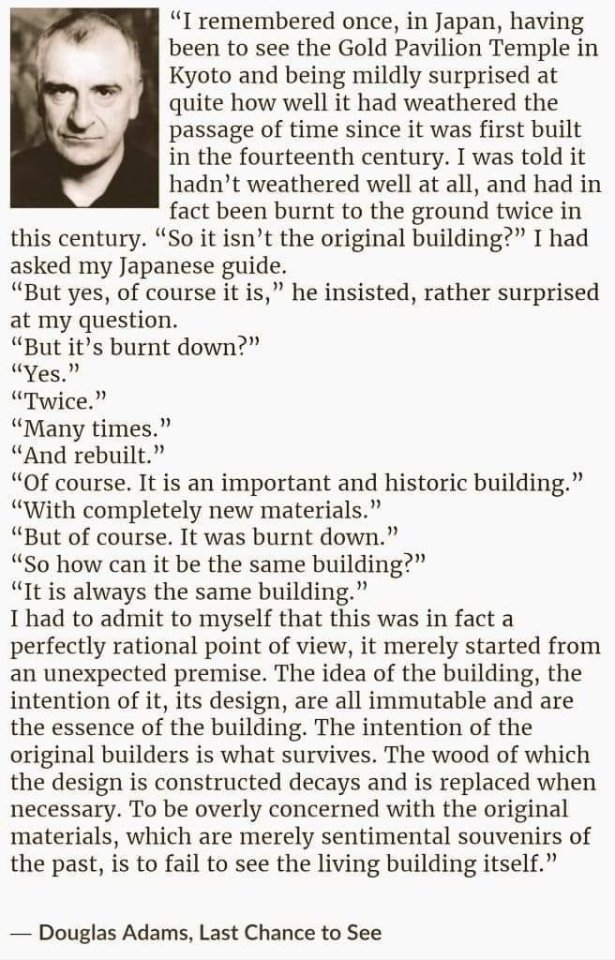
158K notes
·
View notes
Text
The Chanoyu Hyaku-shu [茶湯百首], Part II: Poem 37.

〽 Inishie ha yo-kai¹ nado ni ha toko no uchi kakemono・hana ha nashi to koso kike
[古へは夜會などには床の內 掛物・花は無しとこそ聞け].
“In the past, at night gatherings and the like, in the toko, the kakemono and the flower [arrangement] were never² [displayed], so [I] have heard.”

Neither the kakemono -- which in the early days of chanoyu was usually an ink painting³ -- nor the chabana, can be seen easily at night, and so it was felt that it was better not to display them in the toko during chakai that were being held after sunset.
It should be pointed out that this poem does not specifically forbid the display of a kakemono or chabana during a yo-kai [夜會], it does establish, in writing, a precedent that the beginner would best follow -- until his experience informs him of how things may be done differently.
Accounts of Rikyū’s own gatherings generally adhere to this rule⁴, aside from a span of several years following his entry into Hideyoshi’s household (during which he probably displayed scrolls and floral arrangements at Hideyoshi’s behest -- since his kaiki document gatherings that he hosted on Hideyoshi’s behalf)⁵.

While no counterpart of this poem is found in Katagiri Sadamasa’s collection of the Hundred Poems, the other manuscripts all agree on its meaning.
_________________________
¹The more usual pronunciation for this compound, at least today, would be ya-kai [夜會] -- though it is not known which pronunciation Jōō preferred (since he wrote the word with kanji -- as is also the case with all of the other collections, too). Ya-kai is generally avoided by modern chajin because it sounds* too similar to yakkai [やっかい = 厄介], which means (something is) difficult, burdensome, a nuisance, onerous, troublesome, and so forth -- the sorts of descriptions that young women who had been forced, against their wills, into taking tea lessons by their families might mumble (which possibly suggests the reason why the rather unusual reading “yo-kai” came to be adopted). ___________ *Particularly when one is speaking quickly or emotionally.
²Nashi to koso [無しとこそ] literally means certainly not, not at all, and words to that effect. Koso [こそ] gives added emphasis to the word that precedes it, which in this case is nashi [無し], meaning a situation that does not exist.
³Aside from religious portraits, many of the most desired compositions were executed in black-ink washes that are indistinct even when viewed under normal lighting conditions. Because night time scenes would have been inappropriate to display at night, the panel entitled Píng-shā luò-yàn [平沙落雁] (Geese alighting on a sandy beach) would have been one of the more acceptable scenes from the Xiāo-xiāng bā-jǐng [瀟湘八景] to hang in the toko at such a time. The following is the rendition of the Píng-shā luò-yàn by the late Southern Song monk-painter Mùqī Fǎcháng [牧谿法常; 1210? ~ 1269?], from the collection of the Shō-shō hakkei [瀟湘八景]*, added to the shōgunate’s collection by Ashikaga Yoshimitsu [足利義満; 1358 ~ 1408].

The seal that appears in the lower right-hand corner reads Dōu [道有], which was the name used by Yoshimitsu during his retirement (from 1394 until his death in 1408). Yoshimitsu’s villa, in the hills north of Kyōto (originally styled the Kitayama-dai [北山第], or Kitayama palace, because Yoshimitsu continued to hold the reins of government even after his retirement), was converted into the Rokuon-ji [鹿苑寺] following his death. This temple is better known today as the Kinkaku-ji [金閣寺], on account of the gold-leaf covered building that originally was Yoshimitsu’s residence.
At night, illumination in the tea room came from the light of an oil-lamp and a candle, both of which give off a yellowish light that tends cause paintings of this sort to fade into the paper on which they were painted. This is why beginners were being discouraged from hanging a scroll during night gathering.
⁴According to Rikyū’s two official kaiki, he hosted a total of 24 gatherings in the evening or at night. During the tea year that ran from the Tenth Month of Tenshō 14 [天正十四年] (1586) to the end of the Ninth Month of Tenshō 15 [天正十五年] (1587), Rikyū mentions 10 gatherings that were held either in the evening or at night; and during the period from Hideyoshi and Rikyū’s return from the siege of Odawara in the Ninth Month of Tenshō 18 [天正十八年] (1590), until the last gathering that he held on 24th day of the Intercalated First Month of Tenshō 19 [天正十九年] (1591), just over a month before his death, Rikyū hosted 14 evening or night gatherings. The presence or absence of kakemono and chabana are considered in the following chart:

According to his kaiki, then, Rikyū appears to have frequently displayed either a kakemono or chabana (or both -- photos of these objects are shown below, in the sub-notes) at least up until 1587, but during his final months, he seems to have mostly eschewed both during the gatherings he hosted at night -- which suggests that the display of these things at night may have begun in response to Hideyoshi’s request (since the gatherings documented in Book Two of the Nampō Roku, and in the Rikyū hyakkai ki [利休百會記] were official functions that Rikyū was hosting on Hideyoshi’s behalf)††††. ___________ *The chrysanthemum, which had been plucked from the display that had been set up in front of the Imperial seat during the gyoen [御宴] (court banquet) that had been held earlier that day, had been presented to Rikyū by Hino Terusuke [日野輝資; 1555 ~ 1623]. Terusuke was a kuge [公家] (a court noble -- a hereditary nobleman, rather than someone who had been elevated to the rank of courtier from the military caste), who was serving as the Gon-dainagon [権大納言] or (supernumerary) Chief Counselor of State (senior grade of the Second Rank) at that time. To the stem of the chrysanthemum, Lord Hino had tied a tanzaku on which he had written the verse that he had composed during the banquet. (Tanzaku [短冊] is sometimes translated poetry slip. It is a long slip of special paper -- in the early days not infrequently imported from the continent -- that measures 1-shaku 2-sun long, and 2-sun wide. A piece of paper this size was considered to provide a suitable space for one handwritten waka.) Lord Hino’s poem is not described in the Nampō Roku.
The chrysanthemum, either white or yellow (representing silver and gold, both colors were commonly displayed on auspicious occasions), was probably similar to the large incurved cultivars that are still grown today. These varieties produce very large flowers when all of the side buds are removed as they are growing (as would have been the case, since they were grown specifically as decorations for the Emperor’s banquet). Rikyū’s display of such a flower in the toko was not strictly intended as a chabana, but as a way to do honor to Lord Hino’s gesture.
As for the basket (here and elsewhere), Rikyū has generally not given us any details, so it is impossible to speculate. The four baskets that Rikyū is documented to have owned are shown in the post entitled The Chanoyu Hyaku-shu [茶湯百首], Part II: Poem 34, the URL for which is:
https://chanoyu-to-wa.tumblr.com/post/753446048558694400/the-chanoyu-hyaku-shu-%E8%8C%B6%E6%B9%AF%E7%99%BE%E9%A6%96-part-ii-poem-34
Though whether the baskets used during any of these yo-kai are one of those cannot be proven, one way or the other.
†This was a shikishi [色紙] that had been inscribed by Fujiwara no Sadaie [藤原定家; 1162 ~ 1241], as part of his personal poetry anthology (known as Jū-i gu-sō [拾遺愚草]).
The verse reads:
furu-yuki ni sate mo tomaranu mikari-no wo, hana-no-koromo no mazu kaeriramu
[降る雪に偖もとまらぬ御狩野を、花の衣の先かへりらむ],
which means “the falling snow, even now it does not stop; at Mikari-no [御狩野], [their hunting robes] have been changed into robes of flowers!”
Courtiers wore special hunting robes (kari-ginu [狩衣], shown below) during these excursions -- which usually involved more picnicking and versifying than actual blood sport.
Hana-no-koromo [花の衣], or hana-goromo [花衣] is another name for sakura-gasane no koromo [櫻襲の衣], a style of layered clothing worn since the Heian period, in which a deep red-purple (murasaki [紫], which is a red-purple touched with brown) robe is covered by a thin white robe (resulting in an apparent color similar to the pale pink of cherry blossoms); in poetry, hana-goromo was also used to describe participants at a flower viewing party on whose clothes numbers of the falling petals had settled. The image conjured by the poem is that the wide outer robe and train of the noble huntsmen have become heavily dappled with snowflakes, making them appear to be robes of flowers (hana-no-koromo).

Mikari-no [御狩野] refers to the Imperial Game Preserve, in the mountains south-east of the capital. This is where the Emperor and his court would go on hunting expeditions (during which many of the famous waka-kaishi [和歌懷紙] were written)
Oddly, many Japanese (including museum staff-writers) appear to believe that this poem was included in the Ogura hyaku-nin isshu [小倉百人一首], which does not seem to be the case.
‡Mokkei [牧溪] is the Japanese pronunciation of Mùqī, referring to the Southern Song monk-painter Mùqī Fǎcháng.

The title Jurōjin-no-e [壽老人繪] appears to be a reference to the painting shown above (which is technically said to be a portrait of Lao-tzu, L��ozǐ [老子], from a triptych depicting three renowned philosophers of antiquity). Jurōjin [壽老人] is one name for the god of longevity.
**Yoku-ryō-an bokuseki [欲了庵墨跡] is the name by which Rikyū referred to the scroll that was one of his most prized possessions.

This bokuseki was written by the Yuan period Chán monk Liǎo-ān Qīng-yù [了庵清欲; 1288 ~ 1363].
††Since at least the Heian period, white plum blossoms are poetically associated with the nighttime (because the white plum is generally more strongly fragrant than the pink cultivars, the presence of blossoms can be perceived even when one cannot see them clearly, while on moonlit nights, the white blossoms reflect the moonlight, creating a seductively ethereal scene).
Indeed, ever time that Rikyū displayed a flower at night, it was invariably white.
‡‡Kago-hanaire ni hitoe no shiro-momo [籠花入ニ一重ノ白モヽ] means “in a basket-hanaire, a [branch of] single white peach [blossoms].”
Peach blossoms come in single and double varieties. On this occasion, the peach blossoms were brought to Rikyū as a gift by the Temma shin-monju [天満新門主], the new head priest of Ikkō-shū [一向宗]. After Hideyoshi destroyed the Ishiyama Honngan-ji [石山本願寺] (he subsequently erected Ōsaka castle on the site), he appointed Kyōnyō shōnin [敎如上人; 1558 ~ 1614] as the new head of the sect (shin-monju [新門主]), and built for him a temple at Temma [天満], in the northern part of Ōsaka. Kyōnyō was the oldest son of the 11th head monk, Kennyō [顯如], and had been born at the Ishiyama Honganji.
It seems that this gathering was held on an occasion when Kōnyō shōnin came to Kyōto to pay his respects to Hideyoshi (who had probably invited the monk in order to assure himself that the monk was not inclined to foment rebellion, as his father had been accused of doing). The Ikkō-shū was the Buddhist sect that was blamed for the collapse of the Goryeo dynasty of Korea.
***Tōyo [東與] is the name Rikyu used to refer to a bokuseki written by the Yuan period monk Dōnglíng Yǒng-yú [東陵永璵; 1285 ~ 1365]. Rikyū used the first and last kanji of this monk’s name as his epithet for this scroll.

Dōnglíng Yǒng-yú was a follower of the Cáo-dòng-zōng [曹洞宗] (Sōtō-shū) of Chán, and came to Japan in Shōhei 6 [正平六年] (1351) to proselytize his version of Chán to the Japanese.
†††Moku-an [牧庵]. Rikyū had mistaken the first kanji of this painter’s name. This is a reference to the Japanese monk-artist Moku-an Rei-en [黙庵霊淵; ? ~ c 1345]. He was tonsured as a monk in Kamakura sometime around 1323 (though the name of the temple with which he was affiliated has been lost). Moku-an traveled to China in 1327, and became a renowned painter there, working in the sui-boku [水墨] (black ink sketches) medium; a number of his paintings bear colophons by some of the eminent Chán monks of the day.

A number of these were brought back to Japan by other travelers (including this painting of Kanzan and the foundling Shutoku [寒山拾得]), where they were greatly treasured. Moku-an died in China around 1345.
In the Kun-dai kan sa-u chō-ki [君臺観左右帳記], Nōami [能阿彌; 1397 ~ 1471] considered Moku-an to be a Chinese (Yuan period) monk-painter.
‡‡‡Hoso-kuchi [細口] refers to a bronze hanaire with a narrow mouth.

The hoso-kuchi hanaire owned by Rikyu was named Tsuru-no-hito-koe [鶴ノ一聲] (this hanaire was also known as Tsuru-no-hashi [鶴ノ波子], in reference to the wave-pattern on the foot).
The flower was a single chrysanthemum (kiku ichi-rin [菊一輪] means there was only a single flower on the stem). Since this chakai was held on October 3, 1587 (in the Gregorian calendar), this may have been among the first chrysanthemums to bloom that year.
****Kōrai-zutsu [カウライ筒] was Rikyu’s name for the kake-hanaire shown below.

While this kind of pottery, known as Goryeo to-gi [고려토기 = 高��土器], had been produced since the early Goryeo dynasty (circa the early tenth century), it is virtually identical to the variety of Bizan-yaki [備前焼] fired at Imbe [伊部], near Okayama (the Imbe kilns were established by émigrés from Korea during the second half of the fifteenth century -- the in [伊] in Imbe is the Japanese version of the Korean surname Yoon [尹]); and in some documents from the sixteenth century this hanaire is referred to as the Bizen-tsutsu [備前筒].
As this is a kake-hanaire, a branch of white plum blossoms would have been arranged above eye level -- as if the viewer was looking up toward the night sky through the branches of an old plum tree.
††††The reason why a kakemono or chabana was not displayed in gatherings after Hideyoshi and Rikyū returned from Odawara might be explained by Rikyū’s deepening sense of wabi, as well as a desire to reassert his own sense of propriety (which his feelings of opposition to Hideyoshi’s plans to invade the continent may have emboldened him to express in a way that he had not been willing to do just three or four years before).
⁵During these gatherings, Rikyū entertained Hideyoshi’s guests while they waited for an audience. It was also during these gatherings that Rikyū conveyed certain information, on behalf of Hideyoshi, that it would not have been prudent to bring up during a public audience (when other people would have been able to overhear what was being said). As a result, the staging of the gathering was intended to palpably cast Hideyoshi’s shadow over the chakai; and it appears that Hideyoshi preferred to display scrolls and chabana even at night during his own chakai.
The use of the furo in the small room during the warmer months began in a similar manner -- that is, at Hideyoshi’s suggestion -- with the first mention of the practice* being during their stay in the guest rooms of the Hakozaki-gu [筥崎宮] outside of Hakata (Fukuoka), during the summer of 1587. ___________ *The first use of a furo in the small room was in Hideyoshi’s two-mat Yamazato-maru [山里丸], the chashitsu that was erected as a sort of boathouse on the moat of Hideyoshi’s Ōsaka castle. In this setting, the large iron Temmyō kimen-buro [天妙鬼面風爐] that had belonged to Yoshimasa (and Nobunaga), with the original small unryū-gama resting on a gotoku, was arranged on something resembling a take-daisu [竹臺子] (albeit with the front-right leg removed, and the ten-ita cut on the diagonal into a triangular shape out -- of consideration for the shōkyaku, who would have to bow while seated beside the daisu in this 2-mat room).
This usage, however, was restricted to this one setting until Rikyū accompanied Hideyoshi on the Kyūshū campaign. (In this case, the large Temmyo kimen-buro announced Hideyoshi as Nobunaga’s successor, and Yoshimasa’s heir, to the wealthy citizens of Hakata, whose goodwill -- and money -- would be indispensable assets during Hideyoshi’s invasion of the continent five years later.)
==============================================
◎ If these translations are valuable to you, please consider donating to support this work. Donations from the readers are the only source of income for the translator. Please use the following link:
https://PayPal.Me/chanoyutowa
0 notes
Text
May 24- Kinkakuji and Daitokuji

I was extremely excited for today, as the number one activity that stood out to me when first looking at the itinerary was Kinkakuji. I had always wanted to visit this temple long before the start of our trip (I even often looked at its Google 360 view in high school). When we got there, it was exactly as beautiful as I imagined it. Although the crowds were pretty ridiculous, I got some amazing pictures. I even bought a non-anime-related souvenir for once when I got a little art print of the temple at the nearby gift shop. Daitokuji was also a pretty great experience, as it was nice to be able to sit in the quiet and think for a bit. I feel like Kyoto has somehow felt more exhausting than Tokyo lately, so this was especially nice. During our breakoff time, I continued my anime shopping from yesterday, but today’s store was Mandarake. It was much better than both its Shibuya and Akihabara locations and definitely much better than the Kyoto Bookoff. I ended up buying a whole bunch of volumes of Animage and character song CDs. When I got to the hotel, I decided to use my time at least somewhat productively and finally got around to organizing my luggage. Today felt packed with satisfying moment after satisfying moment, and I’m glad that I was able accomplish so much.
Academic Reflection
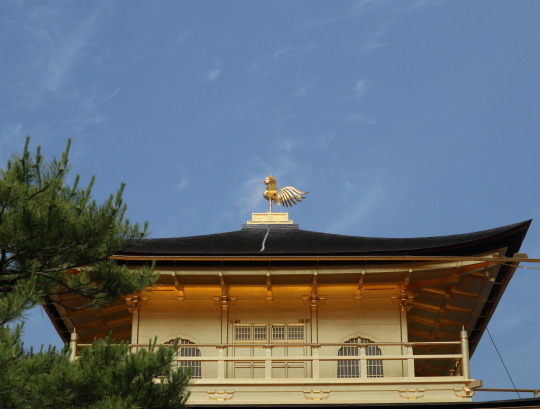
Today’s readings on Kinkakuji involved both a fictionalized backstory about the man who burned down the temple and an analysis of Medieval Japan, which is the period in which the temple was first built. The text on Medieval Japan describes Yoshimitsu, the Ashikaga shogun who presided over the construction of Kinkakuji, as a highly experienced and regal leader with great appreciation for the arts. Looking at the temple today and understanding its fairly recent reconstruction, it is understandable to conclude that Kinkakuji itself reflects these grand artistic characteristics of Yoshimitsu. The gold does not only appear to act as a flaunting of wealth but as a visually appealing design choice. It definitely stood out in terms of appearance compared to all of the other shrines and temples we have visited so far. As such, possibly without even knowing Yoshimitsu’s characteristics as described in the book, one can easily conclude that the individual who oversaw the construction of such a temple would be a highly artistically inclined individual.
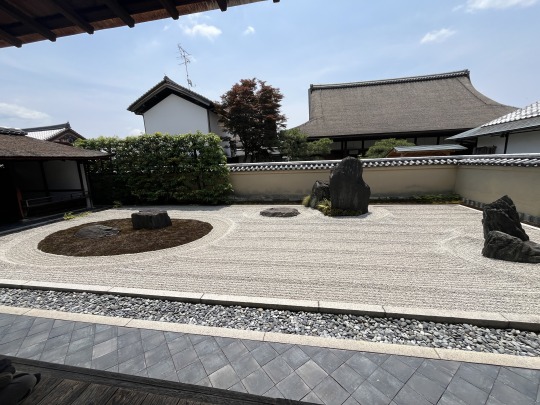
The readings related to our visit to Daitokuji focused on the history of Zen culture, the significance of certain designs in “zen gardens”, and the modern debates over the use of the phrase “zen garden”. One characteristic of the gardens seen today that clearly paralleled with the readings was the use of gravel to represent water and appear as ripples. The text explains how such ripples portray individuals who throws themselves into the sea of Buddha in pursuit of enlightenment. In this case, the boulders that I saw at the garden would represent such individuals, with the surrounding not-yet-rippled gravel representing the sea of Buddha with opportunity for enlightenment.
0 notes
Text
Kyoto
Iniziamo dicendo che la lingua ufficiale è il giapponese.
Si trova 22 ore da noi ed è 7 ore in avanti nel fuso orario.
Cosa dire per rappresentarlo meglio?
Fu la capitale del Paese per più di un millennio (precisamente dal 794 al 1868) ed è nota come "la città dei mille templi". Essendo stata quasi interamente risparmiata dalla seconda guerra mondiale, è considerata il più grande reliquiario della cultura giapponese e per questo inserita nei siti protetti dall'UNESCO.


Cosa vedere a Kyoto? Dei consigli?
Kinkaku-ji, Il Padiglione d'Oro
Ryoan-Ji
Castello di Nijo
Palazzo imperiale
Ginkaku-ji, Il Padiglione d'Argento
Nishiki Market
Gion, il distretto delle geishe
1)Kinkaku-ji, Il Padiglione d'Oro
Una delle immagini iconiche della città di Kyoto: il Padiglione d'Oro (Kinkaku-ji) è uno dei must-see della città. Al centro di un laghetto inserito in un ambiente naturale molto caratteristico e suggestivo, il tempio si sviluppa su tre piani, ognuno dei quali realizzato secondo un diverso stile architettonico.
La sua peculiarità, da cui tra l'altro deriva il nome, è quella di essere completamente rivestito di fogli d'oro. A seconda di come i raggi del sole lo colpiscono, si creano effetti luminescenti davvero particolari.
Si trova nella zona nord della città. Fu costruito nel 1397, inizialmente come villa per lo shogun Ashikaga Yoshimitsu; solo in seguito alla sua morte fu convertito a tempio Zen. Andato a fuoco più volte (l'ultima nel 1950 quando fu incendiato da un monaco del tempio), la struttura attuale risale al 1955.

2) Ryoan-Ji
Tempio buddhista tra i più interessanti di Kyoto, famosissimo per l'enigmatico giardino secco: una composizione di gruppi di pietre adagiate su un letto di ghiaia bianca circondato da un muro in terra. La disposizione delle pietre è tale che da qualunque prospettiva le si osservi la visione di una di esse rimanga sempre nascosta! Non esiste una soluzione, per questo l'opera è considerata un autentico enigma.
Il tempio afferisce alla Scuola Rinzai, una tradizione che pone enfasi nella soluzione di enigmi considerati la via privilegiata per il raggiungimento dell'illuminazione.


3) Castello di Nijo
Patrimonio UNESCO dal 1994, il Castello di Nijo è uno stupendo palazzo nobiliare edificato nel 1603 e abitato dallo shogun Tokugawa Ieyasu.
Tra le bellezze al suo interno meritano una menzione speciale le stanze del palazzo Ninomaru, ovvero la residenza dello shogun. Una delle curiosità più affascinanti di questo palazzo è la presenza del famoso uguisubari, cioè il pavimento dell'usignolo, una specie di antico sistema di allarme che segnalava eventuali intrusioni tramite un delle speciali assi che se calpestate producevano un rumore simile al canto di un usignolo. Non perdetevi la vista del bellissimo giardino!!


4) Palazzo imperiale
Il Palazzo imperiale fu la residenza della famiglia imperiale giapponese fino al 1868, anno in cui la capitale venne definitivamente spostata a Edo, l'attuale Tokyo. Si trova immerso nel parco Imperiale di Kyoto, vero e proprio polmone verde nel cuore della città che già da solo merita senz'altro una visita.
L'attuale palazzo è stato ricostruito nel 1855 e il complesso è racchiuso da lunghe e alte mura difensive, all'interno del quale possiamo ammirare portali, padiglioni e giardini. I palazzi sono ammirabili solo esternamente, mentre sono liberamente accessibili i magnifici giardini.

5) Ginkaku-ji, il padiglione d’argento
Il Ginkakuji è forse uno dei templi più suggestivi della città. Costruito nel 1482, nasceva in origine come residenza privata dello shogun Ashikaga Yoshimasa che si ispirò al padiglione d'oro realizzato dal nonno. Lo shogun voleva far rivestire di foglia d'argento questa costruzione, ma a causa della sua morte avvenuta l'anno successivo, il padiglione rimase per sempre incompiuto.
La residenza fu in seguito convertita in tempio zen. All'interno ci sono anche dei giardini di sabbia in puro stile zen, e un magnifico giardino di muschio, che segue un circuito circolare che costeggia la collina, e dal quale si gode di una incantevole vista su tutto il complesso e sulla città.

6 mercato nishiki
Il mercato Nishiki è il più grande e famoso, della città, situato in centro e visitabile ogni giorno. E' il posto giusto per tutti coloro che amano esplorare una città immergendosi nella tradizione gaastronomica come un vero local.
Il mercato è caratterizzato da un'atmosfera vibrante, grazie alle tante botteghe che affollano questa lunga galleria coperta, vi raccomandiamo di visitarlo e assaggiare le specialità locali.


7 Gion, il distretto delle geishe
Uno dei quartieri più tradizionali di Kyoto, nonché il più famoso distretto delle geisha. È una zona caratterizzata dalle tipiche case di legno dai tetti bassi, dove potete trovare diversi negozi e ristoranti, e ancora diverse ochaya (le case da tè) in attività, dove geiko (geisha in dialetto di Kyoto) e maiko (apprendiste geisha) intrattengono i loro ospiti con musica tradizionale e spettacoli a cui vale assolutamente la pena di andare correndo a vedere.



Cosa mangiare di tradizionale?
Tofu
Sushi
Sashimi
Ramen
Soba e Udon
Tempura
Gyoza
Onigiri
Yatsuhashi(dolce di riso, zucchero e cannella)
wagashi (dolce servito solitamente con té verde)











0 notes
Text
Day 7 April 2 Kyoto
We're a little pressed for time so we Uber to Konkani-ji Temple. Originally a villa belonging to a powerful statesman, it was converted into a Zen temple by shogun Ashikaga Yoshimitsu in the 14th century. The original Kinkaku-ji was destroyed by fire in 1950 and was later rebuilt in 1955.
Supposedly that's real gold leaf covering the structure.


0 notes
Photo

銀閣寺 京都の名所
銀閣寺(ぎんかくじ)は、京都市の東部、哲学の道周辺に位置する仏教寺院です。公式名称は「慈照寺(じしょうじ)」ですが、一般的には銀閣寺として知られています。 銀閣寺は、応仁の乱後に建立されましたが、初代将軍である足利義満の意向により、彼の死後にその別荘地として機能することになりました。義満は金閣寺(鹿苑寺)を建立しましたが、その弟子である応仁の乱の後、孫の足利義政が銀閣寺を建立しました。 銀閣寺の名前は、金箔で装飾された金閣寺とは異なり、元々は銀箔で装飾する予定でしたが、完成に至らず銀閣のままとなりました。そのため、「銀閣寺」と呼ばれるようになりました。 寺院の中心的な建築��は「銀閣」または「宝山楼」と呼ばれる、二階建ての建物です。上層に銀色の塗装が施されておらず、質素な外観を持っています。この建物は、美しい庭園と共に、周囲の景色と調和した風景を提供しています。 銀閣寺周辺には、哲学の道や慈照寺の庭園など、散策するのに適した美しい景観が広がっています。特に紅葉の時期には多くの観光客が訪れ、その風景の美しさが称賛されています。
♪♫♬🎤🎹🎶♪♫♬🎤🎹🎶♪♫♬🎤🎹🎶♪♫♬🎤🎹🎶
Ginkakuji Temple famous places in kyoto
Ginkakuji is a Buddhist temple located in the eastern part of Kyoto City, around Tetsugaku no Michi. The official name is Jishoji, but it is generally known as Ginkakuji. Ginkaku-ji Temple was built after the Onin War, but according to the wishes of Yoshimitsu Ashikaga, the first shogun, it became a villa after his death. Yoshimitsu built Kinkakuji (Rokuonji), but after the Onin War, his grandson Yoshimasa Ashikaga built Ginkakuji. Unlike Kinkaku-ji, which was decorated with gold leaf, Ginkaku-ji's name was originally planned to be decorated with silver leaf, but it was not completed and the name remained as Ginkaku-ji. Therefore, it came to be called "Ginkaku-ji". The main structure of the temple is a two-story building called ``Ginkaku'' or ``Hozanro.'' There is no silver coating on the upper layer, giving it a simple appearance. The building, along with a beautiful garden, offers a landscape in harmony with the surrounding landscape. The area around Ginkaku-ji Temple is full of beautiful scenery that is perfect for strolling around, such as the Philosopher's Path and the gardens of Jisho-ji Temple. Many tourists visit especially during the autumn leaves season, and the beauty of the scenery is praised.
0 notes
Text
Le 3 août
Premier arrêt : le café Shiba.
La race canine Shiba est originaire du Japon. Pour une séance au café, il faut prendre rendez-vous. Pour le prix de la visite on a droit à un breuvage et accès aux chiens pour des caresses. À l’heure de notre rendez-vous on entre dans le café, une petite pièce, ou de petites tables sont disposées. Pas de chaises, on s’assoie au sol et on attend que les Shibas viennent nous voir pour pouvoir les caresser. Le temps écoulé on dit au revoir aux Shibas et on sort pour se rendre compte qu’il y a une file d’attente.
Le Shiba est très populaire chez les Japonais, chien de petite taille, musclé à la queue en tire-bouchon, enjoué et sympathique.

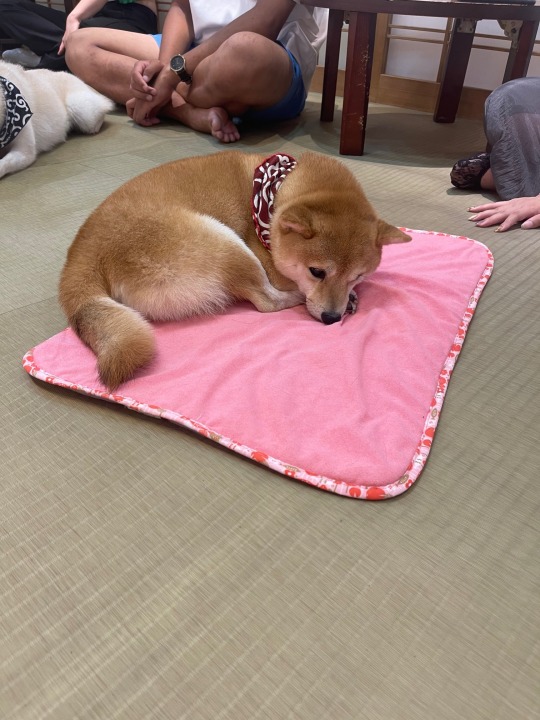
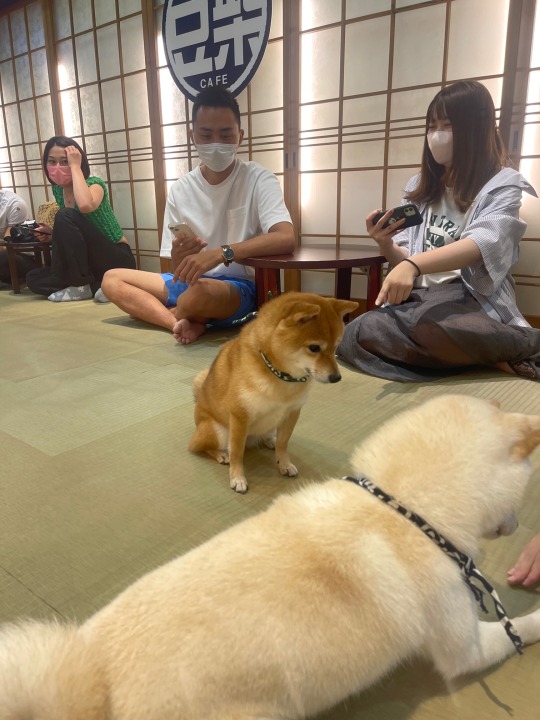

Visite du Kinkaku-ji (temple d’or)
De son nom d’origine Rokuon-ji, célèbre temple bouddhiste surnommé Kinkaku-ji, ce qui signifie pavillon, ou temple, d’or. Ce surnom lui vient du fait que le premier et le second étage du temple sont entièrement recouverts de feuilles d’or.
Désireux de laisser sa marque, le shôgun Yoshimitsu de la ligné des Ashikaga fait construire le pavillon d’or en 1397, qui à l’origine était une villa privée, au nord-est de Kyoto, au pied des montagnes.
À la mort du shôgun Yoshimitsu en 1408, pour respecter le souhait de son père, le shôgun Yoshimochi transforme l’endroit en temple bouddhiste zen pour l’école Rinzai.
Le pavillon d'or a en outre été rénové en 1987 : il a, à cette occasion, reçu une nouvelle couche de feuilles d'or. Le temple est inscrit au Patrimoine mondial de l'Unesco depuis 1994, car il reflète à la perfection l'esthétique japonaise du XIVème et XVème siècles. Depuis 1956, il est aussi classé site historique spécial du Japon et lieu spécial de beauté pittoresque.
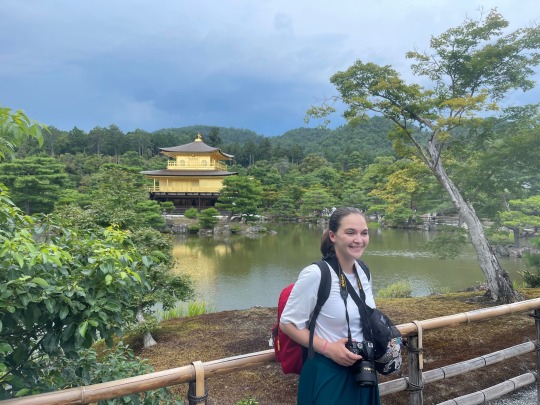
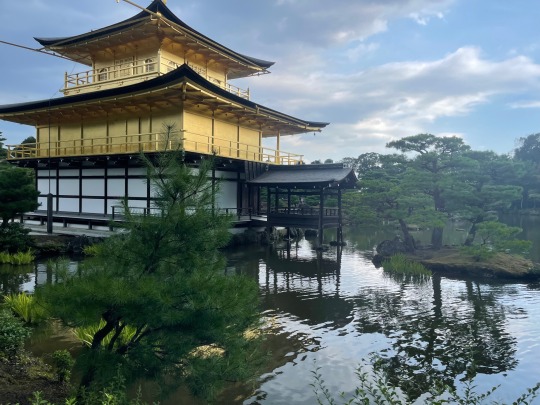


Le Kinkaku-ji est situé au nord-est de Kyoto. Au pied de la face nord-est du mont Kinugasa, une colline recouverte d’une forêt de pins. Le site du temple s’étend sur 93000 m2. Le site est visuellement enchanteur, les pins majestueux, le lac, la forêt, le tout soigneusement aménagé, font de ce site un endroit incontournable.


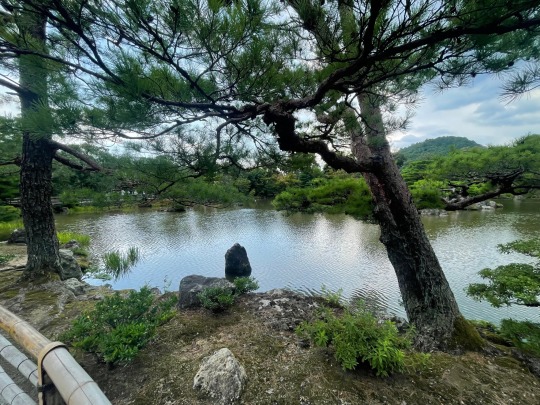
Fushimi Inari-taisha
Mélissa-Anne adore ce sanctuaire dédié à la déesse aux renards Kami Inari. Elle est reconnue comme protectrice des céréales, en particulier le riz. Historiquement, elle est associée à l’abondance et à la richesse, elle devient la patronne des commerces. Le site du sanctuaire s’étend sur la montagne et est composé de plusieurs petits sanctuaires et des centaines de toriis vermillon.
Mélissa-Anne ne l’a jamais visitée de nuit, car bien qu'ouverte 24/7 il reste que la montagne est sauvage et habitée, il y a plusieurs affiches nous enjoignant de faire attention aux sangliers! Donc à trois, les sangliers n’ont qu’à bien se tenir, on fait l’ascension en suivant le chemin de toriis jusqu’au point de vue pour voir les lumières de la ville.
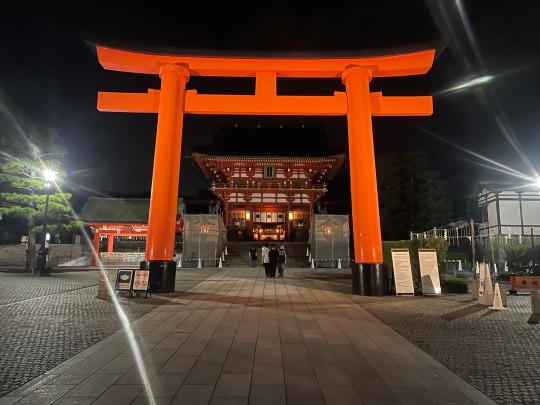




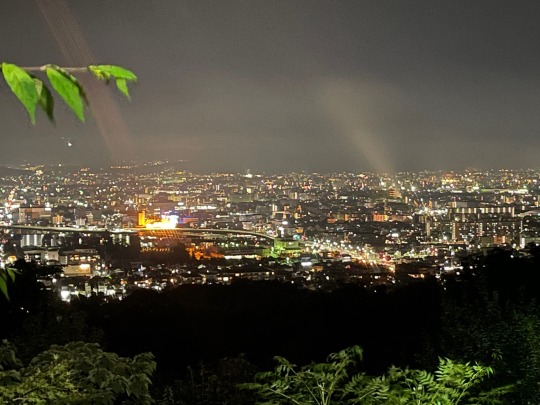
次-suivant
0 notes
Text
Letztes Mal Kyoto
20.04.2023 - Japan, Kyoto [Sama]:
Da wir aufgrund meines Missgeschicks letzte Woche einen Tag in Kyoto verpasst haben, dachten wir uns noch einmal hier einen Zwischenstopp zu machen.
Uns fehlte noch der Kaiserpalast und ein paar Tempel, die wir uns ansehen wollten. Doch erstmal schliefen wir aus! Der Tag gestern hat uns ziemlich fertig gemacht.
Gegen 10 Uhr machten wir uns dann auf den Weg. Es waren 27 Grad und wir freuten uns das perfekte Wetter draußen nutzen zu können. Im 7-Eleven holten wir uns ein willkommenes Frühstück und mampften es im Kaiserpalast-Park bei Sonnenschein. Den Kaiserpalast durften wir uns leider nur von außen ansehen. Die Räumlichkeiten waren für Normalsterbliche leider nicht zugänglich. Zum Glück waren die meisten Gebäude geöffnet und von außen sichtbar.
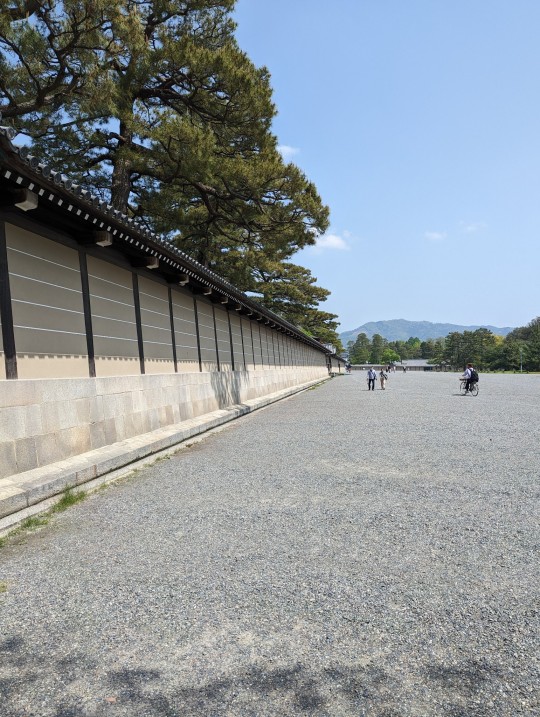
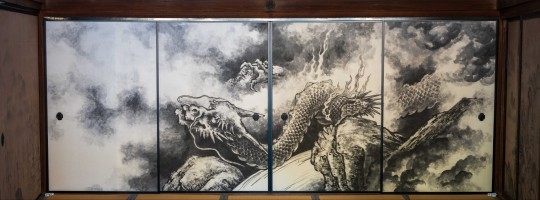
Die Räumlichkeiten, die wir von außen sahen, waren ähnlich aufgebaut wie die im Shogunpalast. Es gab viele Räume, in denen die Gäste warten konnten. Je nach Rang, ein anderer Raum. Die Wände waren bemalt mit Tigermalereien, Kranichen und Kirschblüten. Wobei die Tiger bereits zu dieser Zeit in Japan ausgestorben waren und man sich bei den Malereien nur an vorhandenen Zeichnungen aus China orientierte.
Tatsächlich habe ich mir den Kaiserpalast etwas imposanter vorgestellt, als er am Ende eigentlich war. Klar, wir durften uns nicht das ganze Gelände anschauen, aber selbst die Krönungshalle, die wir nur von weiter weg betrachten durften, haute mich jetzt nicht unbedingt vom Hocker.
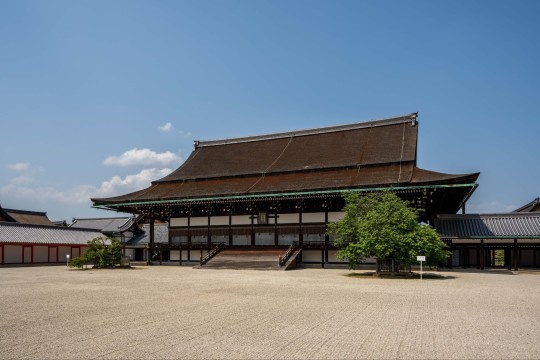
Der schönste Bereich in der Anlage, waren die privaten Räumlichkeiten des Kaisers. Zwar konnten wir wieder einmal nur von außen hineinschauen, aber es reichte. Denn von dort sah man die Wandmalereien, die sich von allen bisherigen unterschieden haben. Zu sehen waren verschiedene Momentaufnahmen eines Geschichtsabschnittes. Diese wurden jedoch über den ganzen Raum hinweg von tiefblauen Wolken begleitet. Bislang sahen wir immer nur sehr gedeckte Farben. Höchstens das Grün der Pinienbäume oder das Goldige in den Räumen kam mal zur Geltung. Aber blau gab es bisher noch nie. Umso schöner und besonderer wirkte es, dass man sie nur durch das Fenster draußen sehen konnte.
Der Kaiser hatte von dort aus einen traumhaften Ausblick auf seinen privaten Garten. Der war riesig, sehr schön verschlungen und mit jedem Schritt von außen daran vorbei, entdeckten wir weitere tolle Dinge darin. Viele kleine Steinlaternen und Brücken versteckten sich unter einer Moosschicht und sogar drei Fischreiher sonnten sich im Teich, als wäre es ihr eigener.


Die Besichtigung war aufgrund des kleinen Zugangsbereiches schnell zu Ende. Also entschieden wir, direkt zum nächsten Punkt auf der Tagesordnung überzugehen. Der goldene Tempel Kinkaku-ji.
Da es eines der Highlights von Kyoto ist, war es natürlich dementsprechend voller Touristen. Die Tempelanlage diente zwischen 1358 und 1408 als Alterwohnsitz des Shoguns Ashikaga Yoshimitsu. Außerdem beinhalten sie die Reliquien des Shoguns. Doch was die Massen hierher zieht, ist mir immer noch ein Rätsel. Ok, er ist komplett mit Blattgold bedeckt und ist das einzige Überbleibsel des ehemaligen Shogun's. Aber davon abgesehen, nicht wirklich schön. Aber vielleicht sind mir die Tempel komplett aus Holz einfach nur lieber.
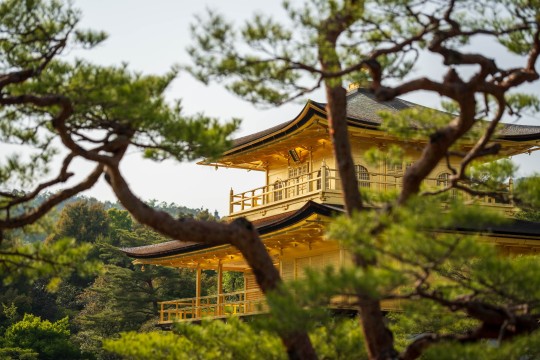

Am goldenen Tempel holten wir uns selbstverständlich unseren Goshuin Stempel ab und machten uns anschließend auf den Weg zum nächsten Tempel. Dem Ryoan-ji. Ein Tempel, der eher nach unserem Geschmack war. Etwas abseits und schön versteckt. Den Tempel konnte man auch von innen besichtigen. Denn dort gab es eine Besonderheit. Ähnlich wie der Komyo-in Tempel im Osten Kyotos besaß auch dieser Tempel einen Steingarten. Wir benoßen die Sonne und betrachteten die Formation des Gartens einige Zeit. Der Garten war umgeben von einer Mauer. Diese hatte eine interessante Färbung. Es handelt sich um Öl, welches bei der Erstellung der Mauer zum Lehm als Schutzschicht hinzugegeben wurde. Mit der Zeit und den Temperaturen "quoll" das Öl aus der Mauer wieder heraus und hinterließ die schöne Färbung.
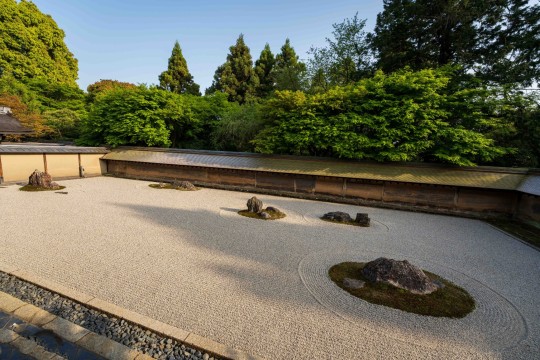
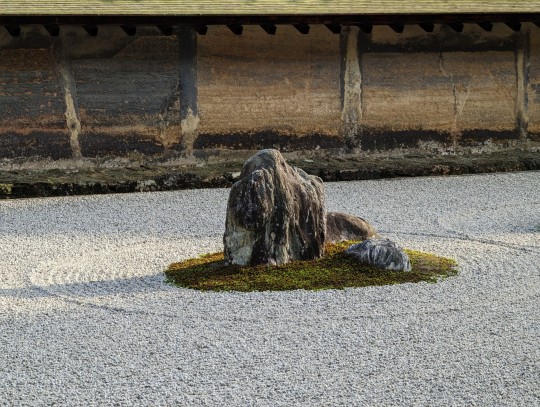
Der Steingarten mit der Öl-Lehmmauer im Hintergrund
Es ist immer wieder schön, durch solch kleine versteckte Tempel zu spazieren, da sie eher an ein japanisches Wohnhaus erinnern. Die Schreine liegen meist am Eingang oder in einem seperaten Raum. Der Rest des Hauses bestehen aus kleinen Zimmern. Umgeben und umhüllt werden die Tempel meist von alten Zypressen, Teichen und angelegten Gärten. Unbeschreiblich schön. Tobi und ich mussten schon feststellen, dass die Gebäude und Natur wirklich unfotogen sind. Auf den Fotos kommt die Schönheit des Ortes nie so wirklich zur Geltung.
Auf der anderen Seite des Tempel befand sich einer der abgelegenen Gärten. Steine und Bäume waren überall mit Moos bedeckt. Zwischen den Pflanzen war ein kleiner Teich angelegt. Es war komplett still. Man hörte lediglich uns beide, wie wir über die knarzenden Holzdielen schlichen und ein leichtes Wasserplätschern. Wir setzten uns und lauschten erneut dem Ort. Dann gaben uns zwei Kröten ein Konzert. Immer wieder wechselten sie sich mit ihrem Gequake ab. Und erneut. Nicht annähernd konnten wir diesen Moment auf Bildern oder Videos festhalten. Wir waren einfach nur dazu eingeladen zu lauschen und zu genießen. Und das taten wir.
0 notes